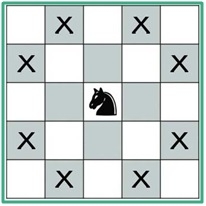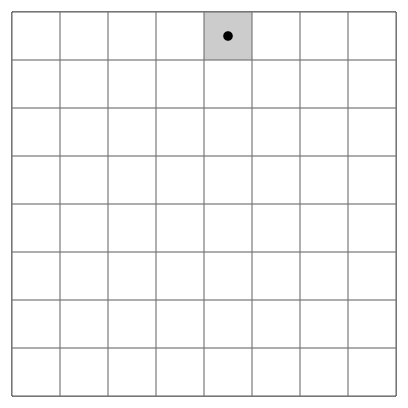A Knight’s Tour --- BackTracking
作者:互联网
A Knight’s Tour
https://www.tutorialspoint.com/The-Knight-s-tour-problem
In chess, we know that the knight can jump in a special manner. It can move either two squares horizontally and one square vertically or two squares vertically and one square horizontally in each direction, So the complete movement looks like English letter ‘L’.
In this problem, there is an empty chess board, and a knight starting from any location in the board, our task is to check whether the knight can visit all of the squares in the board or not. When It can visit all of the squares, then place the number of jumps needed to reach that location from the starting point.
This problem can have multiple solutions, but we will try to find one possible solution.
Input and Output
Input: The size of a chess board. Generally, it is 8. as (8 x 8 is the size of a normal chess board.) Output: The knight’s moves. Each cell holds a number, that indicates where to start and the knight will reach a cell at which move. 0 59 38 33 30 17 8 63 37 34 31 60 9 62 29 16 58 1 36 39 32 27 18 7 35 48 41 26 61 10 15 28 42 57 2 49 40 23 6 19 47 50 45 54 25 20 11 14 56 43 52 3 22 13 24 5 51 46 55 44 53 4 21 12
https://bradfieldcs.com/algos/graphs/knights-tour/
The knight’s tour puzzle is played on a chess board with a single chess piece, the knight. The object of the puzzle is to find a sequence of moves that allow the knight to visit every square on the board exactly once, like so:
Solution
https://www.geeksforgeeks.org/the-knights-tour-problem-backtracking-1/
Backtracking works in an incremental way to attack problems. Typically, we start from an empty solution vector and one by one add items (Meaning of item varies from problem to problem. In the context of Knight’s tour problem, an item is a Knight’s move). When we add an item, we check if adding the current item violates the problem constraint, if it does then we remove the item and try other alternatives. If none of the alternatives works out then we go to the previous stage and remove the item added in the previous stage. If we reach the initial stage back then we say that no solution exists. If adding an item doesn’t violate constraints then we recursively add items one by one. If the solution vector becomes complete then we print the solution.
Backtracking Algorithm for Knight’s tour
Following is the Backtracking algorithm for Knight’s tour problem.
If all squares are visited print the solution Else a) Add one of the next moves to solution vector and recursively check if this move leads to a solution. (A Knight can make maximum eight moves. We choose one of the 8 moves in this step). b) If the move chosen in the above step doesn't lead to a solution then remove this move from the solution vector and try other alternative moves. c) If none of the alternatives work then return false (Returning false will remove the previously added item in recursion and if false is returned by the initial call of recursion then "no solution exists" )Time Complexity :
There are N2 Cells and for each, we have a maximum of 8 possible moves to choose from, so the worst running time is O(8N^2).Auxiliary Space: O(N2)
Code
https://www.tutorialspoint.com/The-Knight-s-tour-problem
#include <iostream>
#include <iomanip>
#define N 8
using namespace std;
int sol[N][N];
bool isValid(int x, int y, int sol[N][N]) { //check place is in range and not assigned yet
return ( x >= 0 && x < N && y >= 0 && y < N && sol[x][y] == -1);
}
void displaySolution() {
for (int x = 0; x < N; x++) {
for (int y = 0; y < N; y++)
cout << setw(3) << sol[x][y] << " ";
cout << endl;
}
}
int knightTour(int x, int y, int move, int sol[N][N], int xMove[N], int yMove[N]) {
int xNext, yNext;
if (move == N*N) //when the total board is covered
return true;
for (int k = 0; k < 8; k++) {
xNext = x + xMove[k];
yNext = y + yMove[k];
if (isValid(xNext, yNext, sol)) { //check room is preoccupied or not
sol[xNext][yNext] = move;
if (knightTour(xNext, yNext, move+1, sol, xMove, yMove) == true)
return true;
else
sol[xNext][yNext] = -1;// backtracking
}
}
return false;
}
bool findKnightTourSol() {
for (int x = 0; x < N; x++) //initially set all values to -1 of solution matrix
for (int y = 0; y < N; y++)
sol[x][y] = -1;
//all possible moves for knight
int xMove[8] = { 2, 1, -1, -2, -2, -1, 1, 2 };
int yMove[8] = { 1, 2, 2, 1, -1, -2, -2, -1 };
sol[0][0] = 0; //starting from room (0, 0)
if (knightTour(0, 0, 1, sol, xMove, yMove) == false) {
cout << "Solution does not exist";
return false;
} else
displaySolution();
return true;
}
int main() {
findKnightTourSol();
}
标签:tour,Knight,solution,---,item,Tour,knight,problem 来源: https://www.cnblogs.com/lightsong/p/16392906.html

